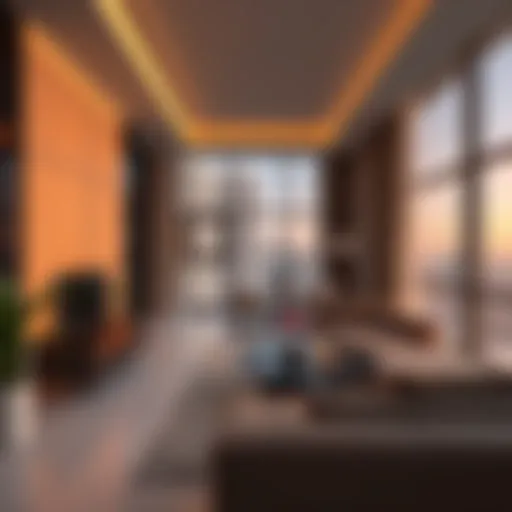Exploring Nasser Square: A Guide to Deira's Heart
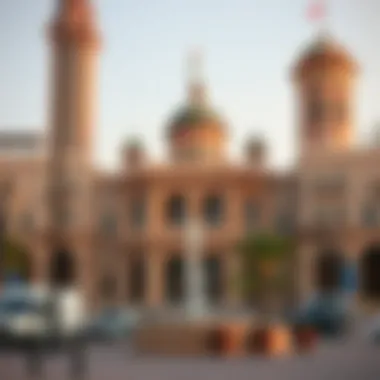

Intro
Nasser Square, situated in the heart of Deira, holds a unique position within the ever-evolving landscape of Dubai. This vibrant area has seen its fair share of transformation, reflecting the rapid changes that define modern Dubai. Historically, it has served as a bustling hub for commerce and trade, attracting both locals and expatriates alike.
As you navigate this dynamic region, it’s essential to grasp not just its architectural beauty and local amenities but also its potential for investment in the Dubai real estate market. Understanding these facets can equip homebuyers and investors with the insight needed to make informed decisions. Whether you’re a seasoned investor or considering your first property purchase, gaining awareness of Nasser Square's offerings is crucial for navigating this complex yet promising market.
In the forthcoming sections, we will delve into the intricate relationship between Nasser Square and the broader Dubai real estate scene, shedding light on its key features and advantages for potential buyers and investors.
Historical Significance of Nasser Square
Nasser Square holds a prominent place in the fabric of Deira, showcasing a rich tapestry of history and urban development. This bustling hub serves not only as a transit point but also as a reflection of Dubai's rapid transformation from a modest fishing village into a sprawling metropolis. Understanding its historical significance is vital as it underscores how culture and commerce intertwine within this thriving community.
Origins and Early Development
The history of Nasser Square traces back to the mid 20th century when Dubai was beginning to see a surge in growth due to the discovery of oil. Initially, it was part of a broader plan to modernize the city and better connect its inhabitants to commerce and trade. During those early days, the square served as a center for local merchants and became a place where traditional markets thrived.
In the earliest layouts, Nasser Square was characterized by simple structures reflective of the era’s architectural trends. You had homes made from traditional materials like coral stones and mud, appearing humble but significant in their role at the genesis of a commercial heart. By 1970s, it became clear that Nasser Square was evolving. Markets sprung up, attracting both locals and expatriates, marking an essential point for trade within Deira and highlighting the area's potential for economic growth.
Transformation Over the Decades
As Dubai geared up for the global stage, Nasser Square underwent significant transformations, mirroring the hustle and bustle of the surrounding city. The architectural evolution reflects Dubai's ambition: from low-rise buildings to towering skyscrapers that dominate the skyline today. This change was not just cosmetic; it represented a broader shift in lifestyle and living standards.
With the introduction of modern facilities and shopping centers, Nasser Square has turned into a comprehensive commercial hub. The metamorphosis over the decades is a testament to Dubai's rapid urbanization. The square began to cater to diverse populations, further enriching its cultural fabric.
“Nasser Square represents a crossroads of tradition and modernity, making it a historic landmark within Dubai's narrative.��”
It is significant to note how Nasser Square has adapted over time to meet both economic demands and socio-cultural shifts. The influx of expatriates and tourists has led to the development of various services and amenities, transforming the square into a melting pot of cultures. As you walk through Nasser Square now, you're strolling through history that vibrates with the sounds of commerce and community—two enduring elements that continue to shape this vital urban space.
Architectural Aspects of Nasser Square
Exploring the architectural elements of Nasser Square is essential, as it reflects the unique blend of tradition and modernity that Dubai embodies. This urban space is not just a convergence point for various activities; it also showcases remarkable designs that tell a story of growth and cultural amalgamation. Understanding these architectural aspects helps grasp the significance of Nasser Square in Dubai’s landscape, benefiting investors and developers looking to navigate the vibrant property market.
Key Structures and Their Designs
Nasser Square is home to various architectural masterpieces that stand as a testament to Dubai's rapid progress. Among these is the Al Ghurair Centre, one of the area's first shopping malls, which, despite its age, continues to be a popular destination. Its design incorporates a mix of modern glass facades and traditional Middle Eastern elements, creating a harmonious balance between the old and the new.
Another notable structure is the Dubai Police Headquarters, featuring sleek lines and contemporary designs enriched with functional beauty. This building emphasizes both security and accessibility. Structures like these highlight the importance of not just aesthetics but also the functionality of architecture in this bustling urban center.
Additionally, the Rolla Mall captures local charm, providing shoppers with a taste of home in a foreign land. The juxtaposition of such varied designs creates an environment that welcomes expatriates and locals alike, fostering community through architecture. Through these structures, one can see how Nasser Square reflects the cultural diversity and lively spirit of Deira.
Cultural Influences in Architecture
Diving into the cultural influences on the architectural styles within Nasser Square reveals a rich tapestry of interactions. For instance, many buildings draw inspiration from traditional Islamic architecture, evident in the use of intricate geometric patterns and arches. This can be observed in the designs of local businesses and mosques in the square, showcasing the enduring significance of Islamic customs.
Moreover, the influence of Western architecture is apparent in the newer constructions. Blending the elements of contemporary architecture with traditional styles results in a unique aesthetic that appeals to a global audience. The Dubai Gold Souk, for example, combines modern retail amenities with a traditional marketplace feel, enhancing the consumer experience.
The evolving architectural landscape in Nasser Square reflects the city’s journey from a humble trading post to a global metropolis. It embodies the aspiration of a diverse population forging a shared identity through design. This cultural melange not only attracts visitors but also presents real estate opportunities, making it an ideal spot for investment.
“Architecture is not merely about the buildings; it's about the community and the identity they create.”
Nasser Square serves as a vibrant canvas where modernity meets tradition, making it a focal point for investors, homeowners, and anyone who appreciates the nuances of urban design. The architectural aspects are vital in understanding how this area fits into the broader narrative of Dubai, emphasizing its relevance in the global real estate landscape.
Economic Impact of Nasser Square
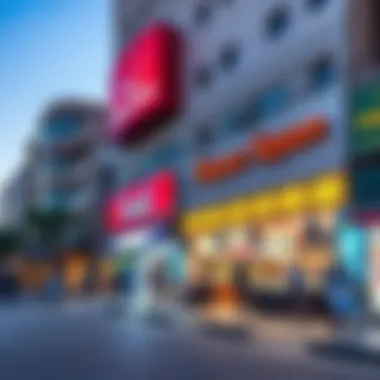

The economic vitality of Nasser Square is not just a byproduct of its strategic location; it serves as a vital catalyst for the wider economic landscape of Deira and beyond. This area has evolved significantly from a simple meeting point into a robust commercial epicenter. As part of this discussion, we’ll dive into how Nasser Square operates as a major commercial hub and the plethora of employment opportunities it fosters.
Nasser Square as a Commercial Hub
Nasser Square stands as a bustling trade and commerce nexus reflecting Dubai's rapid economic ascent. Local business owners and multinational corporations alike recognize its potential, evident in the proliferation of shops, eateries, and service centers. The unique configuration of the square meets various market demands from retail to wholesale, contributing to the flourishing local economy.
One can readily notice the vast array of commercial establishments within this square:
- Retail Outlets: From luxury fashion brands to local handicraft stores, the retail landscape in Nasser Square caters to diverse shopper profiles, appealing to both residents and tourists.
- Food and Beverage: Restaurants and cafes dotted around the square serve authentic cuisine, enhancing the social scene and encouraging daily gatherings.
- Business Services: Many professionals are also drawn to Nasser Square for its business service providers, from legal firms to financial consultants, creating an ecosystem that fuels investment.
All these elements meld together to propel Nasser Square into an indispensable part of Dubai’s retail circuit. The sheer volume of activity here draws foot traffic, which effectively stimulates economic interactions among various stakeholders. As a result, it signals strong market confidence, enhancing property values and encouraging further investment.
Employment Opportunities in the Area
With economic growth comes the creation of jobs. Nasser Square is particularly vital in providing a substantial number of employment opportunities across varied fields. This factor significantly boosts the livelihoods of local residents and expatriates alike.
When observing the job market, here are notable categories where opportunities are most abundant:
- Retail and Hospitality: The thriving shops and restaurants continually seek workers. From sales associates to chefs, the demand for labor remains high, catering to both full-time and part-time seekers.
- Service Industries: Many administrative roles and professional services offer stability. Positions in accounting, marketing, and human resources can be found among businesses operating in the square.
- Logistics and Transportation: Given Nasser Square’s position in the heart of the city, transportation and logistics firms benefit from its accessibility. This adds jobs in warehousing, distribution, and delivery, expanding employment options further.
The employment landscape here is vital for a diversified workforce. As individuals flock to find jobs, it leads to enhanced consumer spending power, which circles back and feeds into the local economy.
"In Nasser Square, the pulse of trade beats strong, with every job created contributing to the lifeblood of Deira's economic ecosystem."
Nasser Square's Role in Dubai's Property Market
Nasser Square’s significance in the Dubai property market is deeply interwoven with its historical and cultural backdrop. As one of the pulsating heartbeats of Deira, the square offers a blend of commercial activity and residential potential. This area represents more than just a point on a map; it embodies a microcosm of Dubai's creative urban evolution and economic vitality. Investing in properties around Nasser Square can serve as a lucrative venture for discerning investors, homeowners, and expatriates alike, who seek both business opportunities and lifestyle enhancements.
Trends in Real Estate Development
In recent years, the property landscape surrounding Nasser Square has undergone a remarkable transformation. Developers are eyeing Nasser Square not just for its location but for its capacity to shape the future of urban living. A few noteworthy trends are evident:
- Mixed-Use Developments: A key trend is the rise of mixed-use developments combining residential, commercial, and leisure spaces. This blend addresses the growing demand for convenience, allowing residents to live, work, and play all within a few steps of their homes.
- High Demand for Rentals: The rental market in Nasser Square is showing robust activity. With an influx of expatriates and professionals relocating to Dubai, there’s a consistent demand for rental units. This high demand paves the way for property investors looking to maximize ROI through rental yields.
- Upgraded Infrastructure: Recent improvements in infrastructure, such as new roads and upgraded public transport facilities, enhance accessibility. These upgrades effectively bolster property values and attract new businesses to the area.
As developers continue to adapt to market needs, properties not only expand in quantity but also quality. High-end finishes and architectural innovations are becoming increasingly common, attracting a sophisticated clientele.
Investment Opportunities Compared to Other Areas
When contrasting Nasser Square with other neighborhoods in Dubai, several factors establish it as a prime investment area:
- Central Location: Being centrally located, Nasser Square connects multiple districts, making it attractive for both businesses and residential buyers who appreciate easy access to all corners of the city.
- Growth Potential: While areas like Dubai Marina or Downtown Dubai have established their reputation, Nasser Square stands on the cusp of significant growth, positioning itself as an emerging hotspot. Investors are beginning to take note of this potential, which could lead to notable appreciation in property values over the coming years.
- Cultural and Community Appeal: The square's cultural richness and diverse community add layers to its attractiveness for investors. Buyers are not just looking for a property; they are interested in being part of a vibrant tapestry of life that Nasser Square provides.
"Investing in Nasser Square is not just about property; it's about becoming part of a historic yet dynamic community that is shaping the narrative of modern Dubai."
In summary, Nasser Square holds a unique value proposition within the Dubai property market. With a perfect blend of location, residential and commercial potential, and an evolving infrastructure landscape, it stands as a worthy consideration for investors and homeowners alike. As the square continues to develop, those positioning themselves now may very well reap the rewards of their foresight.
Amenities and Infrastructure Around Nasser Square
Understanding the amenities and infrastructure available around Nasser Square is crucial for grasping the area's appeal and its attractiveness to prospective investors, homebuyers, and expatriates. Accessibility, varied services, and cultural offerings play significant roles in the quality of life and driving real estate interest within this urban hub. With a blend of modern conveniences and historical richness, Nasser Square presents a unique environment where people can thrive.
Shopping and Dining Options
Nasser Square serves as a vibrant marketplace. Its shopping scene is an eclectic mix of traditional souks and contemporary malls, representing both local culture and global brands.
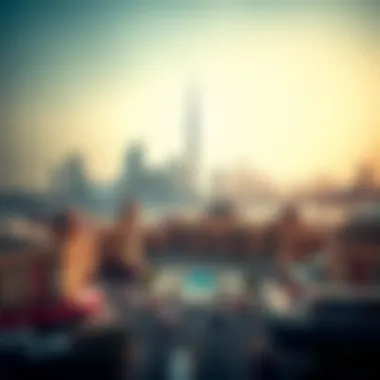

- Souk Al Bahar, a traditional market, is located nearby. Here, visitors can find handcrafted goods, spices, and textiles, preserving the classic Emirati shopping experience.
- For those seeking modern retail experiences, Al Ghurair Centre is just a stone's throw away, offering international brands alongside local boutiques. This mix attracts various shoppers, from everyday consumers to luxury seekers.
Dining is equally diverse. The square and its surroundings boast an array of eateries, ranging from street food stalls serving shawarma to high-end restaurants specializing in international cuisines. For instance:
- Al Falamanki provides an authentic Arabic dining experience amidst a cozy atmosphere, perfect for casual gatherings.
- The Cheese Cake Factory, known for its wide variety of desserts and dishes, attracts families and young professionals alike.
The combination of shopping and dining options adds to the vibrancy of Nasser Square, making it a focal point for both locals and visitors. This integration of amenities supports a sense of community while enhancing property values.
"The convenience of access to shopping and dining options creates a lively atmosphere that can attract both residents and tourists to Nasser Square."
Healthcare and Educational Facilities
Beyond shopping and dining, the presence of essential services such as healthcare and education adds significant appeal to Nasser Square. Proximity to reputable hospitals and schools is often a key consideration for families and individuals when evaluating housing options.
Healthcare facilities in the area are well-established. For instance, Dubai Hospital, which is a short drive away, offers extensive medical services and is well-regarded for its quality.
In terms of education, numerous schools cater to diverse expatriate communities, providing various curricula from British to American models. Notably, The English College is highly recommended, combining local cultural education with international standards. This access to quality education is invaluable for families contemplating a move to the area.
Other noteworthy educational institutions include vocational training centers that prepare individuals for the competitive job market.
By integrating these amenities, Nasser Square not only supports the current residents' needs but also enhances its attractiveness to future real estate investors, maintaining its status as a desirable locale within Dubai.
Transportation Access in Nasser Square
Transportation access is a pivotal aspect when considering the dynamics of Nasser Square in Deira. Its significance cannot be overstated, as the area serves as a central node in Dubai's extensive transport network. This connectivity not only influences local businesses but also shapes the lifestyle of inhabitants and visitors alike. As such, understanding transportation options in and around Nasser Square is essential for potential investors, homebuyers, and even expatriates seeking a vibrant community.
Public Transport Accessibility
Public transport plays an intrinsic role in making Nasser Square accessible and appealing. The area boasts a robust network featuring the Dubai Metro, which links various key destinations across the city. The nearby Al Rigga Metro Station, just a stone's throw from the square, provides a vital link to the Red Line. This strategic position allows commuters quick access to both downtown and residential areas in Dubai, effectively reducing travel time.
In addition to the metro, the local bus service complements the existing public transport options. Numerous bus routes run through the square, connecting it to surrounding neighborhoods and business districts. This integration makes public transport an ideal choice for individuals who prefer to navigate the city without the hassle of owning a car.
Some points worth noting about public transport accessibility include:
- Frequency: Metro trains generally arrive every few minutes during peak hours, ensuring minimal waiting time for passengers.
- Affordability: Public transport is cost-effective, which is appealing to both residents and visitors seeking budget-friendly commuting options.
- User-friendliness: With informative signage and mobile applications providing real-time updates, finding transit information is straightforward for all.
Road Connectivity and Traffic Considerations
In addition to public transport, road connectivity is another key component of accessibility in Nasser Square. The square integrates seamlessly with several major highways and arterial roads, such as Al Maktoum Road and Al Rebat Street. This connectivity is particularly advantageous for those traveling by car, making it a preferred choice for many business professionals and families residing in the vicinity.
However, the increased traffic can lead to congestion during peak hours, particularly before and after work. It's wise for newcomers to familiarize themselves with alternative routes and travel timings to avoid potential delays. While this might seem like a hindrance, the vibrant economic activity the area generates often compensates for any inconveniences caused by traffic.
Moreover, the rise in urban cycling and walking has also been noted, as efforts to enhance pedestrian walkways around Nasser Square continue to evolve:
- Dedicated Cycling Paths: Always a plus for the environmentally conscious, cycling routes are increasingly being integrated.
- Enhanced Crosswalks: Safety is paramount, with better crosswalks and signage boosting pedestrian ease.
In essence, while traffic and road dynamics may present challenges, the overall accessibility of Nasser Square—from public transport options to road connectivity—enhances its reputation as a desirable location for investment and residence.
Community and Lifestyle in Nasser Square
Nasser Square is not just a geographical landmark; it serves as a heartbeat of the neighborhood, characterized by its rich community spirit and diverse lifestyle offerings. The vibrant sociocultural fabric here can significantly affect the day-to-day experiences of both residents and visitors. In a place known for its dynamic urban landscape, exploring the unique community aspects of Nasser Square reveals how it has evolved and what makes it special today.
Demographics of the Area
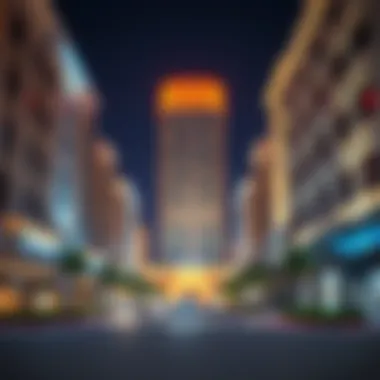

The demographics of Nasser Square paint a colorful picture of an area where cultures and backgrounds converge. The locale is home to a melting pot of residents, mainly comprising expatriates from various countries. Nationalities represented here span from Indians and Pakistanis to Egyptians and Filipinos, creating an environment that is rich in cultural exchanges.
This diversity is essential for investors and homeowners because it also highlights the multifaceted needs of the community. For instance, the preferences for housing range from high-end apartments to more modest accommodations, attracting not just wealthy expatriates but also professionals and families looking to establish roots.
- Population Composition: The demographic split can be broadly characterized as 60% foreign nationals and 40% local Emiratis.
- Age Distribution: A significant segment of the population is between the ages of 25 to 40, engaging with various businesses and educational institutions in the area, thus driving demand for housing and services.
- Family Dynamics: Many families residing here seek kid-friendly facilities, like parks and schools, which increases the appeal for potential investors targeting family-oriented developments.
Cultural Events and Community Engagement
Community engagement initiatives in Nasser Square are abundant and play a crucial role in fostering a sense of belonging among diverse populations. Events often showcase local traditions and customs, providing platforms for cultural exchange and understanding. Festivals celebrating local Emirati heritage, such as the Dubai Shopping Festival and Eid celebrations, unify communities through shared experiences.
A notable event that has gained traction in recent years is the Nasser Square Cultural Festival, which includes art exhibitions, performances, and culinary showcases. Such festivities not only highlight local talents but also attract attention from tourists and potential investors, creating new opportunities for local businesses.
"In Nasser Square, community events are like a vibrant tapestry, weaving together diverse threads of culture, creating unity in diversity."
The active participation in these engagements leads to enriched living experiences, where residents often express their appreciation for accessibility to cultural programming. Moreover, community centers serve as catalysts for social interaction, offering workshops, fitness classes, and art sessions tailored to various age groups.
Overall, the community and lifestyle in Nasser Square extends beyond simple living; it cultivates a lifestyle filled with cultural richness, community engagement, and diversity, making it an attractive proposition for investors, homeowners, and expatriates looking for more than just a place to live.
Challenges Facing Nasser Square
As Nasser Square stands as a focal point in the rapidly evolving landscape of Dubai, it is not without its set of challenges. Understanding these issues is paramount for investors, homeowners, and developers who have their sights set on this bustling area. In this section, we will delve into two critical challenges: urbanization and overcrowding, alongside environmental considerations. Navigating these concerns is essential for making informed decisions regarding investments and community planning.
Urbanization and Overcrowding Issues
Nasser Square has witnessed unprecedented growth over the decades. The urban sprawl has resulted in new developments popping up like daisies after rain; however, this rapid growth also brings its setbacks. As more people flock to the area, the strain on existing infrastructure and services intensifies.
- Increased Population Density: The attraction of Nasser Square as a commercial and residential hub means more residents, leading to congestion. Streets that once felt spacious can now become bottlenecks during peak hours. This not only impacts traffic but also diminishes the quality of life for those residing nearby.
- Pressure on Public Services: With a growing population, local services such as waste management, public transport, and recreational areas start struggling to keep up. Authorities must find a balance between accommodating new residents and maintaining the service quality that current inhabitants rely on.
- Social Dynamics: The influx of various cultures and demographics can create a rich tapestry of life in Nasser Square, yet it can also lead to social friction. Different lifestyle choices and living habits can clash, complicating community relations.
"Urbanization often resembles a double-edged sword, especially in thriving areas like Nasser Square. The benefits of growth must be carefully weighed against the challenges it brings."
Environmental Considerations
As the skyline of Nasser Square rises, so do concerns regarding its environmental footprint. The interaction between such an urban environment and the natural landscape requires deliberate and thoughtful approaches. Environmental issues may include:
- Air Quality Deterioration: The increase in vehicular traffic and construction activities can lead to a noticeable decline in air quality. It’s crucial for local governments and developers to consider sustainable practices to combat pollution.
- Green Spaces: As buildings reach for the sky, the availability of parks and recreational areas can diminish. For an area like Nasser Square, ensuring access to green spaces is essential—balancing concrete jungle with patches of nature provides both aesthetic appeal and mental relief to city dwellers.
- Water Management: With the added pressure on water resources from increased population and infrastructure demands, careful planning is required. Efficient water management strategies, such as rainwater harvesting and greywater recycling, can mitigate some of these concerns.
Future Prospects for Nasser Square
Understanding the future prospects of Nasser Square is essential for anyone looking at the evolving real estate landscape in Dubai. This area is not just a pin on the map; it symbolizes the dynamic growth of this vibrant city. With its unique blend of historical significance and urban development, Nasser Square is set to become a keystone location for investment, influencing both local and expatriate communities. Nurtured by ongoing urban planning initiatives, the square is poised to adapt to the needs of a changing population while preserving its cultural heritage.
Anticipated Developments and Urban Planning
Looking ahead, urban planning in Nasser Square aims at balancing growth with sustainability. The Dubai government has laid out a strategic development plan to enhance local infrastructure. This includes access to advanced transportation options and the upgrading of existing facilities. Some of the anticipated developments involve:
- Smart City Integration: Implementation of smart technological solutions aimed at enhancing the quality of life for residents. Consider features like smart traffic lights that adapt in real-time to vehicular flow.
- Green Spaces: Increasing the number of parks and recreational areas that allow residents to enjoy nature amidst the urban sprawl. This caters to both environmental sustainability and community wellness.
- Mixed-Use Developments: Projects blending residential, commercial, and leisure spaces are on the rise, providing convenient living options. Imagine a scenario where you can shop, dine, and reside within a stone’s throw.
The groundwork for these developments indicates a significant shift from traditional urban models to a more integrated approach to city living. Moreover, such initiatives align with the UAE’s vision for a modern, sustainable Dubai, enhancing the overall life quality while attracting foreign investments.
Potential for Real Estate Growth
As urbanization continues to surge, the potential for real estate growth in Nasser Square is nothing short of remarkable. Analysts speculate that property prices will rise as demand for residential units increases, making it an attractive market for investors. Factors supporting real estate growth include:
- Demand from Expatriates: Nasser Square has always been a choice locale for expatriates seeking to establish a home in Dubai. The mix of cultures fosters a welcoming community, making it increasingly popular.
- Strategic Location: Situated near key business districts and cultural landmarks, it remains a hub for locals and tourists alike. Proximity to the Dubai Metro station enhances its appeal for professionals commuting to work.
- Investment Incentives: The UAE's government is actively promoting foreign investments. Offers like tax exemptions on rental income and streamlined property ownership processes further inject enthusiasm into the market.
In a nutshell, Nasser Square is not just a place on a map; it’s a dynamic, evolving area with an exciting trajectory. The focus on inclusive development coupled with strategic economic positioning positions it as a crown jewel in Dubai's urban landscape. Investors and homeowners alike should keep an eye on this rising prospect.
"In times of change, the right location can turn a mere property into an asset that appreciates in value and fulfillment of life."
For further reading on urban development and investment in real estate, sources such as Wikipedia, Britannica, and forums like Reddit might offer some interesting insights.

